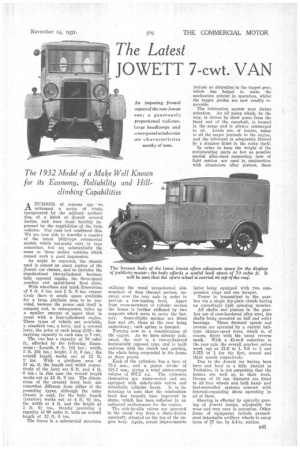The Latest JOWETT 7-cwt. VAN
Page 59

If you've noticed an error in this article please click here to report it so we can fix it.
The 1932 Model of a Make Well Known for its Economy, Reliability and Hillclimbing Capabilities ANUMBER of seasons ago we witnessed a series of trials, inaugurated by the military authorities, of a batch of Jowett covered lorries, and were most forcibly impressed by the capabilities of the little vehicles. Our road test confirmed this. We are now able to describe a number of the latest 1932-type commercial models which naturally vary in type somewhat, but are substantially the same as those earlier vehicles which caused such a good impression.
As might be expected, the chassis used is almost an exact replica of the Jowett ear chassis, and so includes the Standardized two-cylindered horizontally opposed engine, the three-speed gearbox and spiral-bevel final drive.
With wheelbase and track dimensions of 8 ft. 6 ins, and 3 ft. 9 ins, respectively there is ample space available for alarge platform area to be provided, because the power unit itself is compact and, in consequence, takes up a smaller amount of space than is usual with a four-cylindered engine. Three types of vehicle are available, a standard van, a lorry, and a covered lorry, the price of each being 1138; the carrying capacity in each case is 7 cwt.
The van has a capacity of 70 cubic ft., afforded by the following dimension.s:—Length, 4 ft 301 ins.: width, 3 ft. 10-1ins.; height, 3 ft. 9 ins.; the overall length works out at 12 ft
2 ins. With a platform area of 27 sq. ft. the length and width respectively of the lorry are 6 ft. and 4 ft. 6 ins.; in this ease the overall length works out at 13 ft. 9 ins. The dimensions of the covered lorry body are somewhat different from either of the preceding types, although the same chassis is used, for the body length (interior) works out at 4 ft. 61
the width at 4 ft. and the height at 3 ft. 91 ins., thereby providing a capacity of 69 cubic ft. with an overall length of 12 ft. 6 ins.
The frame is a substantial structure
utilizing the usual pressed-steel side members of deep channel section, upswept over the rear axle in order to provide a low-loading level. Apart from cross-members of tubular section the frame is further stiffened by two supports which serve to carry the bat
tery. Semi-elliptic springs are fitted fore and aft, those at the rear being underslung ; each spring is damped.
Turning now to a consideration of the engine. As we have already indicated, the unit is a two-cylindered horizontally opposed type, and is built unitwise with the clutch and gearbox, the whole being suspended in the frame at three points.
Each of the cylinders has a bore of 75.4 mm., and a piston stroke of 101.5 tom., giving a total piston-swept volume of 907.2 c.c. The. cylinders themselves are water-cooled and are equipped with side-by-side valves and detachable cylinder heads. It is interesting to note that the combustion head has recently been improved in shape, which has been reflected in an enhanced performance for the engine.
The side-by-side valves are operated in the usual way from a chain-driven camshaft, situated on the top of the engine body. Again, recent improvements include an alteration in the tappet gear, which has helped to make the mechanism quieter in operation, whilst the tappet guides are now readily removable.
The lubrication system next claims attention. An oil pump which, by the way, is driven by skew gears from the front end of the camshaft, is located in the sump and is always submerged in oil. Leads are, of course, taken to all the major journals in the engine, and the lubricant is adequately filtered by a strainer fitted in the sump itself.
In order to keep the weight of the reciprocating parts as low as possible special alloy-steel connecting rods of light section are used in conjunction with aluminium alloy pistons, these latter being equipped with two compression rings and one scraper.
Power is transmitted to the gearbox via a single dry-plate clutch having an exceedingly light spinning member.
All shafts and pinions in the gearbox are of case-hardened alloy steel, the shafts being mounted on ball and roller bearings. Three forward speeds and reverse are operated by a central balltype change-speed lever, which is, of course, fitted with the usual reverse catch. With a 43-to-8 reduction in the rear axle the overall gearbox ratios work out at 21.6 to 1, 9.9 to 1 and 5.375 to 1 for the first, second and third speeds respectively.
Due to the Jowett ear having been born and bred in a hilly district in Yorkshire, it is not surprising that the brakes are well up to their work. Drums of 10 ins, diameter are fitted to all four wheels and both handand foot-controlled systems connect with internal-expanding shoes operating in all of them.
Steering is effected by epicyclic gear-. ing of Jowett design, adjustable for wear and very easy in actuation. Other items of equipment include pressedsteel detachable artillery wheels to carry tyres of 27 ins. by 4A-in. section.




































































































